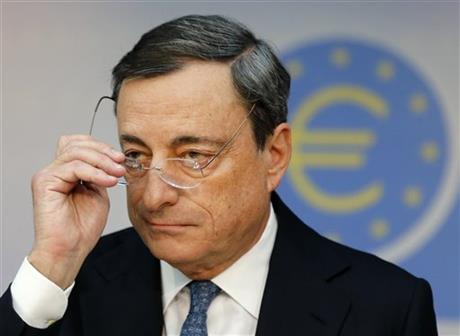
By DAVID McHUGH
President of European Central Bank Mario Draghi adjusts his glasses during a news conference in Frankfurt, Germany, Thursday, Nov. 7, 2013, following a meeting of the ECB governing council. The ECB lowered its key interest rate from 0.5 to 0.25 per cent. (AP Photo/Michael Probst)
Mario Draghi
President of European Central Bank Mario Draghi listens to a question during a news conference in Frankfurt, Germany, Thursday, Nov. 7, 2013, following a meeting of the ECB governing council. The ECB lowered its key interest rate from 0.5 to 0.25 per cent. (AP Photo/Michael Probst)
Mario Draghi
President of European Central Bank, ECB, Mario Draghi is on his way to a news conference in Frankfurt, Germany, Thursday, Nov. 7, 2013, following a meeting of the ECB governing council. The ECB lowered its key interest rate from 0.5 to 0.25 per cent. (AP Photo/Michael Probst)
Mario Draghi
President of European Central Bank Mario Draghi speaks during a news conference in Frankfurt, Germany, Thursday, Nov. 7, 2013, following a meeting of the ECB governing council. The ECB lowered its key interest rate from 0.5 to 0.25 per cent. (AP Photo/Michael Probst)
Prev
1 of 4
Next
FRANKFURT, Germany (AP) — The European Central Bank startled investors Thursday with a surprise cut in its benchmark interest rate aimed at boosting a hesitant recovery in the 17 countries that use the euro.
The bank lowered the benchmark refinancing rate to a record low 0.25 percent from 0.5 percent at a meeting of its 23-member governing council in Frankfurt. Stock markets rallied and the euro slumped on the news.
Recent economic data, such as unexpectedly low inflation, showed the eurozone’s economic recovery remains weak. But most economists thought the bank would wait to offer more economic stimulus at least until December, when it will have new forecasts from its own staff.
The surprise move underlined the ECB’s greater flexibility under President Mario Draghi, who took office in November, 2011. His predecessor, Jean-Claude Trichet, was more resistant to lower rates.
A lower refinancing rate makes it cheaper for banks to borrow from the ECB. The hope is that would encourage banks to charge less for loans, making it easier for companies to expand and create jobs.
“It is obvious that the ECB under President Draghi has become more pro-active than under any of his predecessors,” analyst Carsten Brzeski wrote in a note to investors.
The current eurozone inflation rate — at 0.7 percent, well below the ECB’s goal of just under 2 percent — has also untied the bank’s hands to try further monetary stimulus without fear that it could stoke inflation. Draghi held the door open for more cuts, although the current rate is now near zero.
“In principle, we could cut even further,” he said, noting that inflation is expected to remain low for a prolonged period of time.
He offered no apology for taking markets by surprise, saying that the bank’s previous stance was based on the inflation outlook — and that was now different.
Still, many economists have said the rate cut would have a mostly symbolic impact. The problem is that banks in several countries are not passing on the lower rate because they are worried about their own finances. To address that, the ECB is beginning a year-long check of bank finances, aiming to ferret out hidden losses and force struggling banks to strengthen their finances by raising new capital or restructuring.
The ECB is also extending its offer of unlimited short-term cheap credit for banks until mid-2015. The offer aims to ensure banks do not run into problems raising ready cash to operate and can focus instead on lending, which is needed for growth. It also lessens worry over a possible cash shortage among banks when two, massive rounds of 3-year emergency credit expire in early 2015 and have to be paid back.
Analysts have said another such long-term offer could be coming, but Draghi gave little indication other than to say “we have a whole range of instruments we can activate.”
The ECB theoretically could also engage in so-called quantitative easing — using newly created money to buy bonds in the open market. That tool has been deployed by the U.S. Federal Reserve, Bank of England and Bank of Japan. But analysts say the ECB faces serious technical and political obstacles to doing that because it is a single central bank for 17 countries. That raises the question of how to apportion the purchases among 17 different bond markets.
The economy of the 17 European Union countries that use the euro emerged from recession in the second quarter with a modest 0.3 percent increase in output. High unemployment and cutbacks in government spending in countries burdened by high debt continue to hold back growth.
The rate cut announcement sent stocks markets in Germany and France up about 1.5 percent.
It also pushed the euro down sharply, to $1.3375 from $1.3520 before the announcement. That’s something the ECB won’t mind, as the stronger euro can hold back eurozone exports. The prospect of lower interest rates can send a currency’s exchange rate down by diminishing investment returns, lowering demand for investments denominated in that currency.



